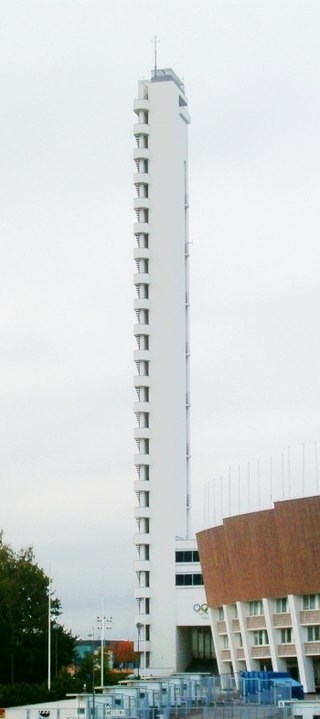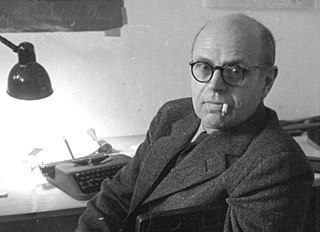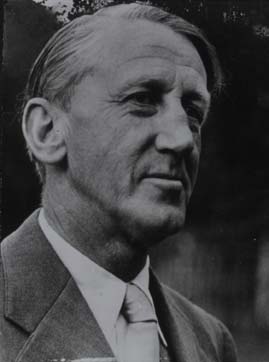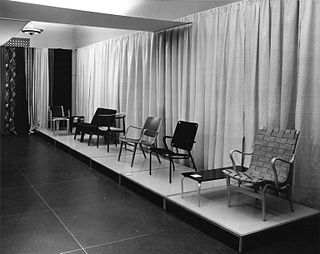Related Research Articles

Arne Emil Jacobsen, Hon. FAIA 11 February 1902 – 24 March 1971) was a Danish architect and furniture designer. He is remembered for his contribution to architectural functionalism and for the worldwide success he enjoyed with simple well-designed chairs.
The culture of Denmark has a rich scientific and artistic heritage. The astronomical discoveries of Tycho Brahe (1546–1601), Ludwig A. Colding's (1815–1888) neglected articulation of the principle of conservation of energy, and the foundational contributions to atomic physics of Niels Bohr (1885–1962); in this century Lene Vestergaard Hau in quantum physics involving the stopping of light, advances in nano-technology, and contributions to the understanding of Bose-Einstein Condensates, demonstrate the range and endurance of Danish scientific achievement. The fairy tales of Hans Christian Andersen (1805–1875), the philosophical essays of Søren Kierkegaard (1813–1855), the short stories of Karen Blixen, penname Isak Dinesen, (1885–1962), the plays of Ludvig Holberg (1684–1754), modern authors such as Herman Bang and Nobel laureate Henrik Pontoppidan and the dense, aphoristic poetry of Piet Hein (1905–1996), have earned international recognition, as have the symphonies of Carl Nielsen (1865–1931). From the mid-1990s, Danish films have attracted international attention, especially those associated with Dogme 95 like those of Lars Von Trier. Denmark has had a strong tradition of movie making and Carl Theodor Dreyer has been recognised as one of the world's greatest film directors.

In architecture, functionalism is the principle that buildings should be designed based solely on their purpose and function. An international functionalist architecture movement emerged in the wake of World War I, as part of the wave of Modernism. Its ideas were largely inspired by a desire to build a new and better world for the people, as broadly and strongly expressed by the social and political movements of Europe after the extremely devastating world war. In this respect, functionalist architecture is often linked with the ideas of socialism and modern humanism.

Poul Henningsen was a Danish author, critic, architect, and designer. In Denmark, where he often is referred to simply as PH, he was one of the leading figures of the cultural life of Denmark between the World Wars.

Kaare Klint was a Danish architect and furniture designer, known as the father of modern Danish furniture design. Style was epitomized by clean, pure lines, use of the best materials of his time and superb craftsmanship.

Forum Copenhagen is a large multi-purpose, rentable indoor arena located in Frederiksberg, Denmark. It hosts a large variety of concerts, markets, exhibitions and other events. The venue can hold up to 10,000 people depending on the event. The Forum operates as a convention center, concert hall and indoor arena.

Scandinavian design is a design movement characterized by simplicity, minimalism and functionality that emerged in the early 20th century, and subsequently flourished in the 1950s throughout the five Nordic countries: Denmark, Finland, Norway, Sweden, and Iceland.

Bing & Grøndahl was a Danish porcelain manufacturer founded in 1853 by the sculptor Frederik Vilhelm Grøndahl and merchant brothers Meyer Hermann Bing and Jacob Herman Bing. The trademark backstamp for Bing & Grøndahl (B&G) porcelains is the three towers derived from the Coat of Arms of Copenhagen. The company's Seagull dinnerware series became known as the "National Service of Denmark" in the 1950s when it was found in one tenth of all Danish households. In 1987 the company merged with its primary competitor, the Royal Porcelain Factory under the name Royal Copenhagen.

Danish modern is a style of minimalist furniture and housewares from Denmark associated with the Danish design movement. In the 1920s, Kaare Klint embraced the principles of Bauhaus modernism in furniture design, creating clean, pure lines based on an understanding of classical furniture craftsmanship coupled with careful research into materials, proportions, and the requirements of the human body.
Cultural radicalism was a movement in first Danish, but later also Nordic culture in general. It was particularly strong in the Interwar Period, but its philosophy has its origin in the 1870s and a great deal of modern social commentary still refer to it.
Hvedekorn is a Danish language literary magazine published in Copenhagen, Denmark, since 1920. It is one of the Danish publications which improved the cultural journalism in the country.

Tilskueren was a monthly cultural and literary magazine published in Copenhagen, Denmark, between 1884 and 1939. It was continuation of another magazine, Det nittende Aarhundrede, which was founded by Georg and Edvard Brandes. The subtitle of Tilskueren was Maanedsskrift for Litteratur, Samfundsspørgsmaal og almenfattelige videnskabelige Skildringer.
Klingen was an art magazine based in Copenhagen, Denmark. The magazine existed between 1917 and 1920.
Axel Johannes Salto was a Danish ceramic artist of international fame. His works also include painting, graphic design and illustrations for books, jewelry and textiles. As author and founder of the art magazine Klingen (1917–1919), Salto was also an important contributor to the art debate in Denmark.

Thorkild Henningsen was a Danish architect. He is best known for his design of numerous terraced housing developments, especially Bakkehusene at Bellahøj whish is listed on the Danish Registry of Protected buildings and Places. In spite of his early death, he also had a significant influence on Danish residential architecture of the 1920s through his work for Landsforeningen Bedre Byggeskik as well as through his writings in newspapers, architectural journals and Kritisk Revy.
Paula Tatiana (Tania) Ørum is a Danish feminist, literary historian and writer who has specialized in women's and gender studies. Together with Lene Koch, in the 1970s she was one of the driving forces behind recognition of the need for university courses in women's research. This later led to the Danish gender and women's research centre KVINFO, to which she contributed from 1981 to 1990. Her own research has focused on the relationship between gender and literature as can be seen in her Pamelas Døtre (1985). Since her retirement in 2015 from the University of Copenhagen's Department of Arts and Cultural Studies, she continues to be an active writer and speaker, especially in connection with avant-garde art in the 1960s.
Helhesten was an arts and literary magazine which was published between 1941 and 1944 in Copenhagen, Denmark. It was one of the leading publications during World War II in the region.
Bauhaus was a quarterly avant-garde art and design magazine which existed in the period between 1926 and 1931 with some interruptions. It was launched by a German art movement with the same name and financed by an art group called Kreis der Freunde des Bauhauses. It had significant effects on the Danish art magazines such as Kritisk Revy and Linien.
References
- 1 2 3 4 5 6 7 Torben Jelsbak (2019). "From Bauhaus to Our House – Kritisk Revy, Popular Culture, and the Roots of "Scandinavian Design"". In Benedikt Hjartarson; Andrea Kollnitz; Per Stounbjerg; Tania Ørum (eds.). A Cultural History of the Avant-Garde in the Nordic Countries 1925-1950. Vol. 36. Leiden; Boston, MA: Brill Rodopi. pp. 860–878. ISBN 978-90-04-38829-1. ISSN 1387-3008. ISSN 2214-0808.
- 1 2 3 4 5 Kerry Greaves (2019). The Danish Avant-Garde and World War II: The Helhesten Collective. New York, NY: Routledge. p. 135. ISBN 978-0-429-88590-7.
- 1 2 Mark Mussari (2016). Danish Modern: Between Art and Design. New York: Bloomsbury Publishing. p. 28. ISBN 978-1-4742-2368-3.
- 1 2 3 4 5 6 7 Bjarne S. Bendtsen (2013). "Copenhagen: From the Ivory Tower to Street Activism". In Peter Brooker; Andrew Thacker (eds.). The Oxford Critical and Cultural History of Modernist Magazines. Vol. III. Oxford: Oxford University Press. p. 630. ISBN 978-0-19-965958-6.
- 1 2 Per Olaf Fjeld; Emily Randall Fjeld (2019). Louis I. Kahn: The Nordic Latitudes. Fayetteville, AR: University of Arkansas Press. p. 19. ISBN 978-1-68226-112-5.
- ↑ "Poul Henningsen (1894-1967)". Danish.net. Retrieved 23 April 2020.
- ↑ Torben Jelsbak (2011). "Arbejdshypotesen om en menneskehed: Tidsskriftet Kritisk Revy mellem avantgarde og populærkultur". Danske Studier (in Danish) (106).